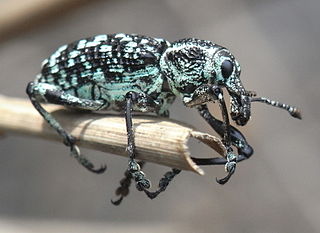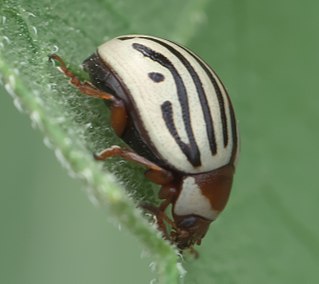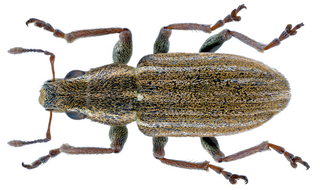
Weevils are beetles belonging to the superfamily Curculionoidea, known for their elongated snouts. They are usually small – less than 6 mm in length – and herbivorous. Approximately 97,000 species of weevils are known. They belong to several families, with most of them in the family Curculionidae. It also includes bark beetles, which while morphologically dissimilar to other weevils in lacking the distinctive snout, is a subfamily of Curculionidae. Some other beetles, although not closely related, bear the name "weevil", such as the biscuit weevil, which belongs to the family Ptinidae.

Phyllobius is a genus of weevils containing at least 60 described species, some of which are commonly found in Europe.

Chrysolopus spectabilis is a species of weevil found in south-eastern Australia. It was discovered during James Cook's first voyage, and became one of the first insects to be described from Australia. The weevil measures up to 25 mm (1.0 in) long and includes distinctive metallic green and black scales. It is found only on 28 species of the plant genus Acacia.

The palm weevil Rhynchophorus ferrugineus is one of two species of snout beetle known as the red palm weevil, Asian palm weevil or sago palm weevil. The adult beetles are relatively large, ranging between 2 and 4 centimetres long, and are usually a rusty red colour—but many colour variants exist and have often been classified as different species. Weevil larvae can excavate holes in the trunks of palm trees up to 1 metre (3.3 ft) long, thereby weakening and eventually killing the host plant. As a result, the weevil is considered a major pest in palm plantations, including the coconut palm, date palm and oil palm.

Anthonomus eugenii is known as the pepper weevil. This beetle feeds and lays eggs on plants in the genus Capsicum and a few species in the genus Solanum. A. eugenii is native to Mexico, however, it is an important pest of Capsicum in Florida, Puerto Rico, and Central America.

Larinus is a genus of true weevils, comprising about 180 species, mostly in the Palaearctic region with some species introduced to North America. Turkey appears to have a significant diversity of the group, with more than 50 species recorded in the eastern part of the country.

Sitona is a large genus of weevils in the family Curculionidae native to the Nearctic and Palaearctic regions. Over 100 species have been described. Sitona is easily distinguished from related genera by flat, recumbent scales on the mandibles, by the absence of an oval scar on the mandibles, by short and broad rostrum with a deep, longitudinal, median groove, and by dense scales on the body.

The Entiminae are a large subfamily in the weevil family Curculionidae, containing most of the short-nosed weevils, including such genera as Entimus, Otiorhynchus, Phyllobius, Sitona, and Pachyrrhynchus. In comparison with their stunning diversity, only a few of these weevils are notorious pests of major economic importance. Entimines are commonly encountered in the field, including urban environments, and abundant in entomological collections.

Phyllobius glaucus is a species of weevil found across Europe, especially in carrs. It is a pest of a variety of fruit trees, but has little economic effect. It was first described by Giovanni Antonio Scopoli in 1763.

The maize weevil, known in the United States as the greater rice weevil, is a species of beetle in the family Curculionidae. It can be found in numerous tropical areas around the world, and in the United States, and is a major pest of maize. This species attacks both standing crops and stored cereal products, including wheat, rice, sorghum, oats, barley, rye, buckwheat, peas, and cottonseed. The maize weevil also infests other types of stored, processed cereal products such as pasta, cassava, and various coarse, milled grains. It has even been known to attack fruit while in storage, such as apples.

Otiorhynchus armadillo is a species of broad-nosed weevil belonging to the family Curculionidae, subfamily Entiminae.

Acanthoscelides obtectus, the bean weevil, is a species of bruchid beetle. The species was described in 1831 by Thomas Say.

Hypera postica, commonly known as the alfalfa weevil, is a species of beetle in the superfamily Curculionoidea; it can be found in alfalfa fields throughout Europe. Considered a destructive threat to alfalfa production in North America, several accidental introductions have been successfully countered though the use of a variety of biological control species.

Hypera nigrirostris, commonly known as the lesser clover leaf weevil, is a species of weevil that is native to Europe and northern Africa and has been introduced to North America and Japan. Both adults and larvae feed on red clover and other plants in the family Fabaceae.

Zygogramma exclamationis, commonly known as the sunflower beetle, is a species of leaf beetle belonging to the family Zygogramma. It is regarded as a pest of sunflower crops in North America.

Sitona lineatus, commonly known as the pea leaf weevil is a species of weevil with a Palearctic distribution. It is a common pest of beans, peas, and other plants in the family Fabaceae. Adult beetles of S. lineatus measure 3.4-5.3 mm in length. They are characterized by a series of colored scales arranged in alternating lines (striae) on the elytra; it is from this characteristic where the species gets its name lineatus meaning 'lined' or 'striped'. The head and pronotum also have fine pointed setae amongst the scales. The antennae are clubbed, pointed and preceded by 7 segments. The femora is dark, but tibiae and tarsi are red. As a member of Order Coleoptera (beetles) their forewings are modified to form hardened covers over the thorax and abdomen, with the hindwings for flight underneath.

Phyllobius argentatus is a species of short-nosed weevil commonly known as the silver-green leaf weevil.
Trichobaris trinotata, commonly known as the "Potato stalk borer", is a species of weevil in the family Curculionidae. It is found in North America where it is a pest of potato plants, the larvae tunnelling inside their stems.

Curculio sayi, the small or lesser chestnut weevil, is a species of true weevil in the family of beetles known as Curculionidae.
Euplatypus parallelus, previously known as Platypus parallelus, is a species of ambrosia beetle in the weevil family Curculionidae. The adults and larvae form galleries in various species of tree and logs. It is native to Central and South America but has spread globally, is present in Africa and is well established in tropical Asia.


















